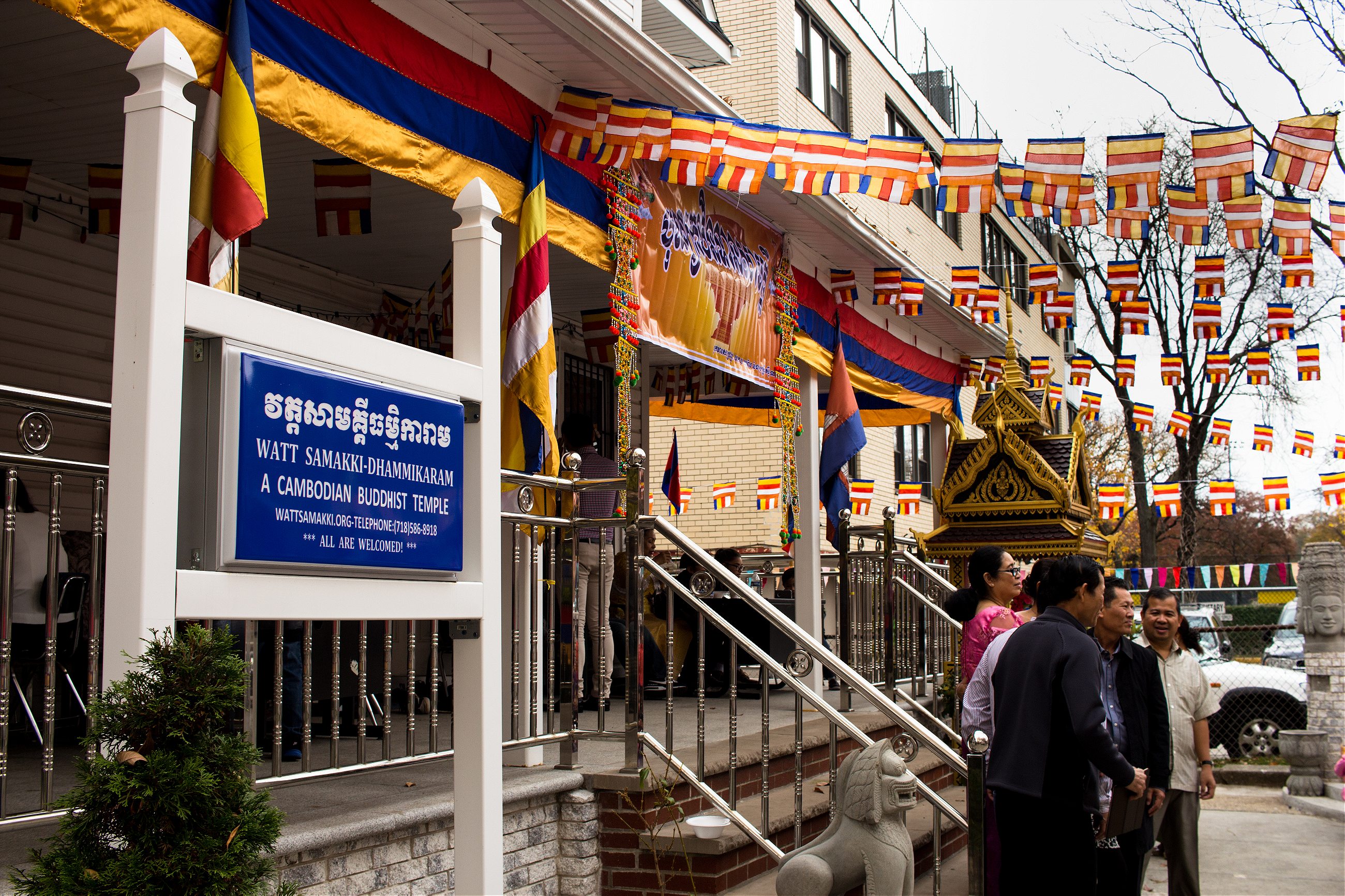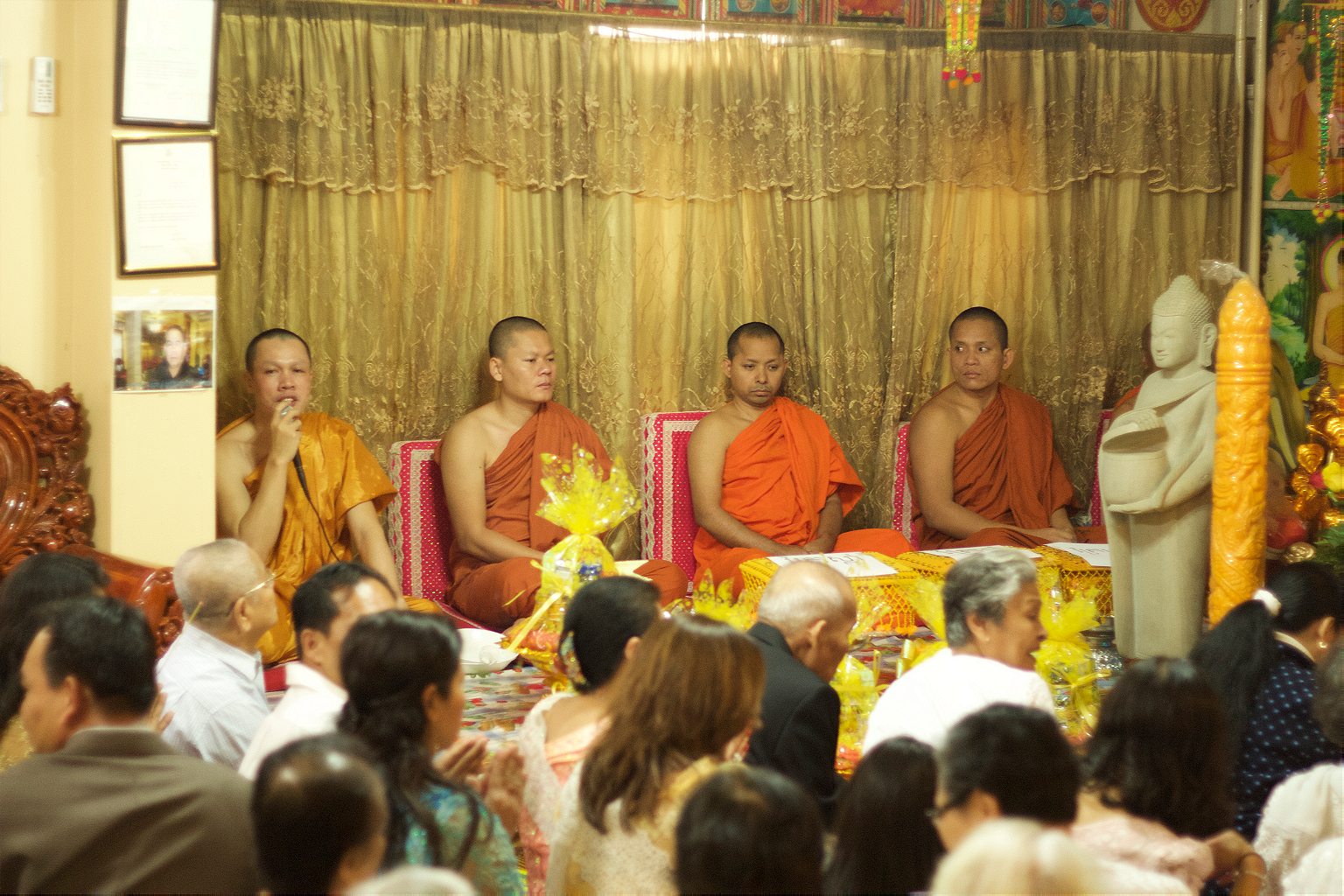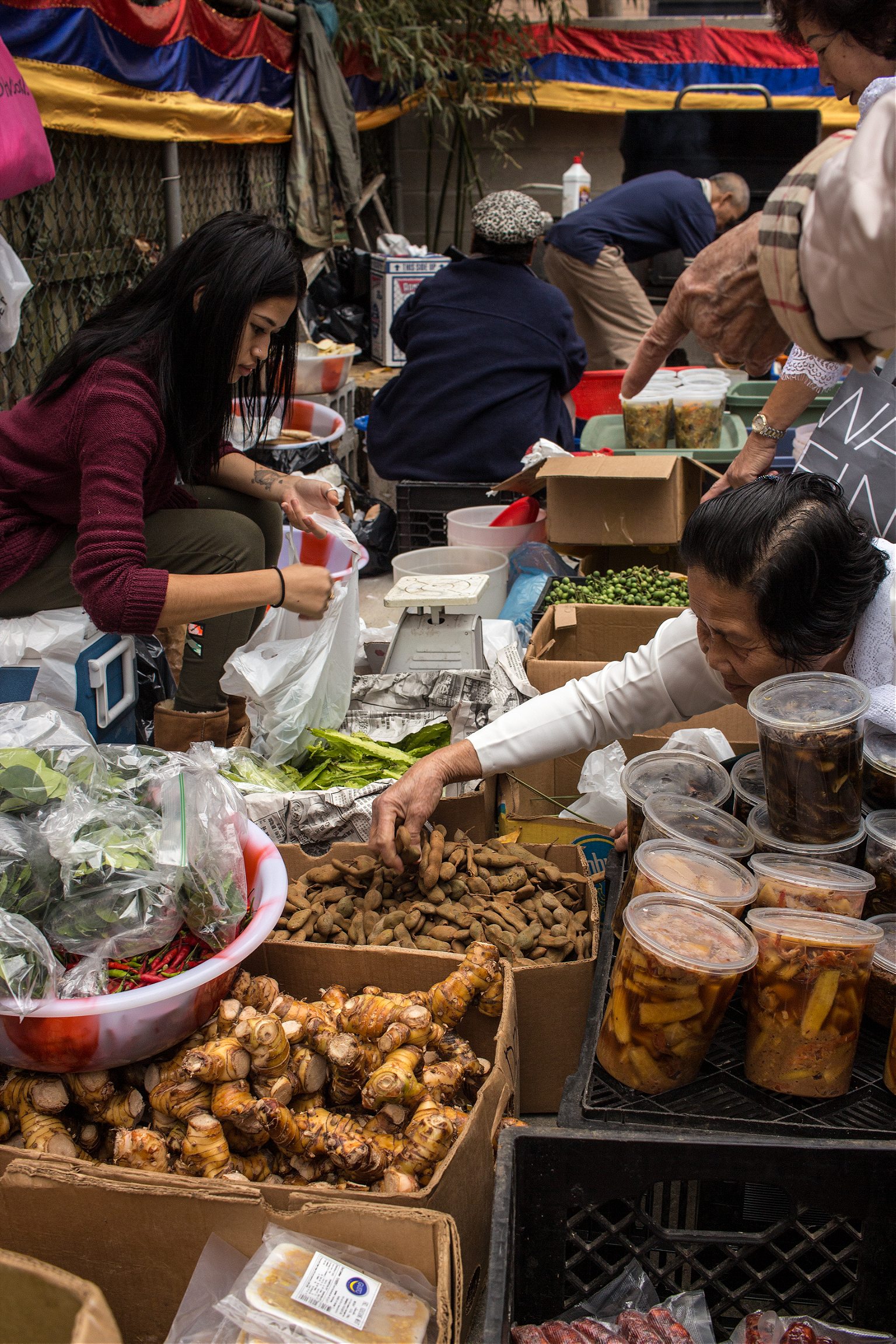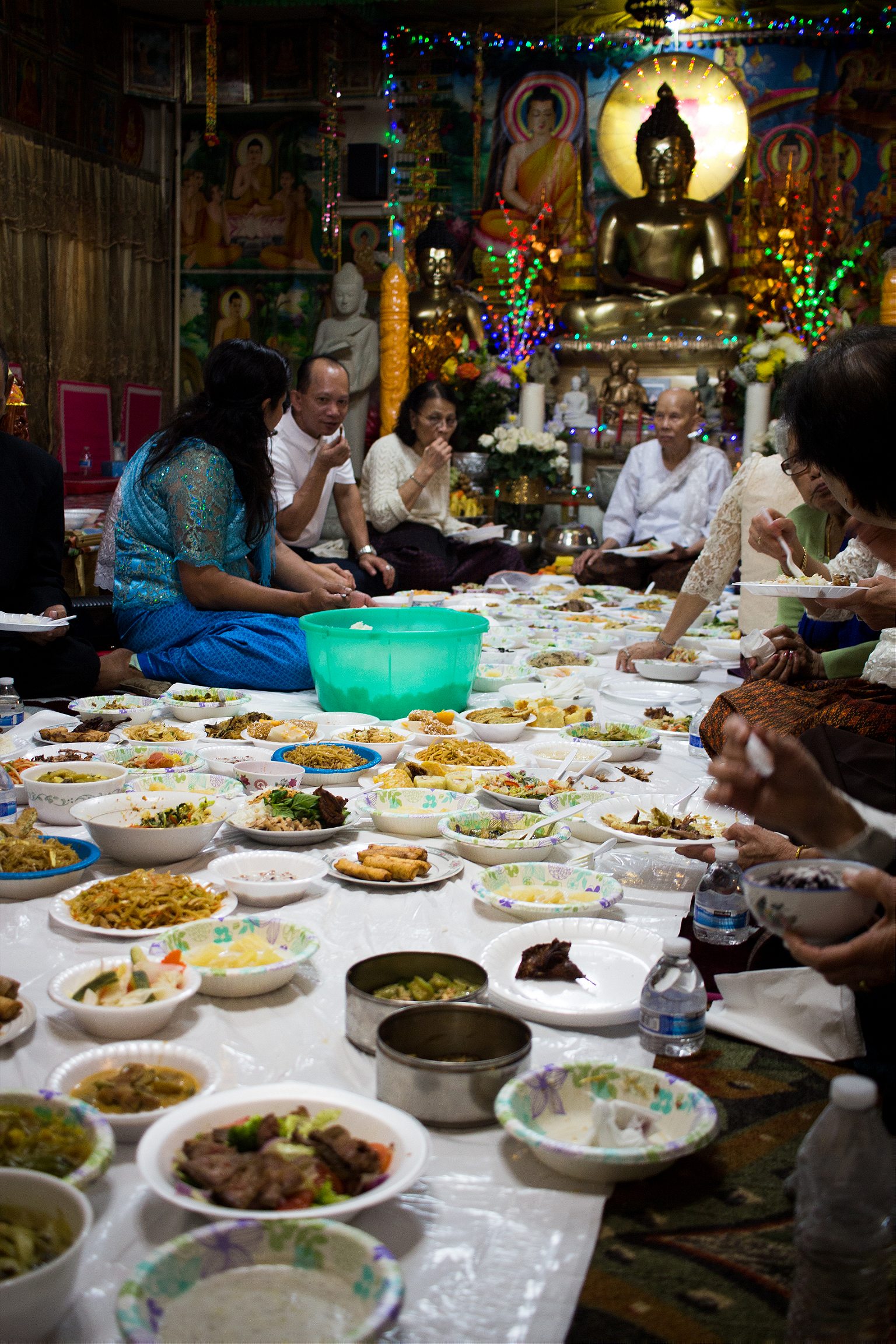Decades of turmoil drove thousands of Cambodians to the great melting pot of New York. Today, one holy place in Brooklyn preserves a fading cultural heritage.
Baw-baw, a type of rice porridge, is ladled into paper bowls and passed down the line, followed by a procession of garlic flakes, spicy chutney, black pepper, chopped leeks, and cubes of blood sausage. The backyard is dense with the smell of rice and coconut milk and sounds of chatter in khmer. Inside, a photo of Barack Obama hangs in the living room between images of the house’s resident monks and plastic-wrapped illustrations of the life of Siddhartha. The basement is busy with old women arranged in an assembly line, churning out a dizzying variety of dishes in preparation for the largest annual Cambodian gathering in New York City.
Watt Samakki-Dhammikaram Buddhist temple has stood off Brooklyn’s Prospect Park since its founding in 1983. It remains the only Cambodian temple in the city. The house, decorated for today’s revelry with wide silk ribbons in the red, blue, and gold colors of Cambodia, is on most days as unassuming as the rest of the homes that occupy the otherwise quiet neighborhood. But this weekend hundreds of Cambodians will gather here to celebrate Kathen, a holiday that marks the end of the rainy season.

New York’s Cambodian community, once a significant part of the city’s ethnic patchwork, has in recent years been lost to the larger Cambodian hubs of Philadelphia and Long Beach, California, which offer lower crime, cheaper rent, and a vibrant and preserved culture. The community here has shrunk significantly, and aging local leaders worry that their religious and linguistic traditions will be lost with the youngest generation. Watt Samakki remains the only arena in New York where these generations converge.
Though the ceremony begins in earnest tomorrow, the holiday begins today with a small prayer held in front of a large ornate Bhudda shrine decorated with Christmas lights. The temple’s Achar, an unordained prayer leader chosen by the community, begins reciting the ceremony as the older members of the congregation hum along.
These are the original founders of New York’s Cambodian community, all of whom arrived during the first and largest wave of refugee immigration in the early 1980s. A power struggle between communist and anti-communist forces in Cambodia led to the rise of the brutal Khmer Rouge regime in 1975. Desperate civilians fled Pol Pot’s genocidal campaign, which sought to institute an agrarian Marxist state. People who lived in the cities, spoke a foreign language, or wore glasses—a supposed marker of the intelligentsia—were subject to torture and execution.
By 1979, when the Vietnamese military intervened, the regime had murdered 1.7 million people. Hundreds of thousands of starving Cambodians fled to refugee camps on the border with Thailand. Many more lost their lives at the border, which had been rigged with landmines. Some were given asylum abroad while others remained until the 1990s brought the return of relative stability in Cambodia.

Mean Mak, the temple’s surly treasurer, in his 60s and an oversize wool blazer, speaks unabashedly in his thick accent about his story of coming to America. Working as a field agent cracking down on the narcotics industry and studying law in Cambodia, Mak took his wife across the border to Thailand immediately following Pol Pot’s assumption of power. Mak arrived in New York in 1975, after the U.S. had adopted the Indo-China Migration and Refugee Act.
Shortly after the end of the US war in Vietnam, Church groups and local organizers paired the refugees with patrons who offered money and other assistance to integrate Cambodians into the States. Many of the early immigrants spoke no English and took the only jobs they could find, mostly in the cleaning industry. Mak managed to find work as a runner on Wall Street during the paper trading days.
About 75,000 refugees arrived during the period from 1980 to 1984. Roughly half settled in Long Beach, since it was near a military base where refugees were processed. Despite the efforts of the recipient American communities, many Cambodians from the era never learned to speak English. Even after 20 years, only one in five had become naturalized U.S. citizens.
The next morning sees the temple’s patio flooded with slippers and shoes and the backyard bustling around a pop-up food market selling salted crabs, dried pickles, grilled pork skewers, snow cones, and more than a few items that no one seemed to be able to translate.

The ceremony begins around 10 a.m., as monks make their way to the shrine dressed in orange robes. The Achar begins his round of prayers and chants. At all times during the ceremony at least one monk is filming the congregation on his iPhone or tablet. After about an hour, the attention turns to a monk who has traveled from Philadelphia and has seated himself in one of two thrones in the room. He begins to lecture to an attentive group, with occasional jokes to lighten the mood.
All the while, Mak is pacing impatiently on the sidelines, at times taking photos with his point and shoot, at times checking Facebook. “I’m a bad Bhuddist. I don’t do all of that. I just live by the five pillars. What more do you need?”
Mak only recently took the job as Watt Samakki’s treasurer and he admits he’s never been very involved in the community. But under his leadership, the struggling temple took on a new life. He instituted new financial policies within the temple, mandating that all transactions be made publicly available on the website he designed and built himself.
“I did not want to take a job where people would always say, ‘He’s stealing.’ I took the job on the condition that I run the entire temple’s business my way.” His efforts have helped revive the temple’s fortunes. “Last year we raised $110,000, and every cent has been accounted for.”
That number was especially impressive considering the temple’s declining popularity in recent years. At the height of the Cambodian migration wave, there were an estimated 800-1,000 families living in Brooklyn, the center of the refugee community. But when the 1990s brought higher rents and a series of robberies targeting the Cambodian population, much of the community fled. Only about 400 families remained in Brooklyn, and many of those soon spread around the city and surrounding communities.

After his speech, the visiting monk leads the congregation to the backyard to feast. Spring rolls sizzle in woks of hot oil. Noodles are piled beside fish cakes and cold chicken. The drum set in the corner of the yard comes to life, animated by Bon Jovi instrumentals performed by a sinewy man wearing a compression shirt.
Inside the temple, the monks eat quietly, their eyes scanning the array of dishes presented them. Huddled around blankets on the floor before them are the founding members of Cambodian community, partaking in an equally impressive spread of home cooked dishes.
Between bites of Lap Khmer, ceviche-style beef salad, Kim Huot Kiet, a representative of the Cambodia Society, bemoans the state of New York’s Cambodian community. “This area used to be entirely Cambodian. But now, the temple is all. My friend used to run the Cambodia society. After he died, I wanted to keep it running. But after me there is no one to take over.”

Back in the 1980s, Kiet recalls, the community was a close knit one, and people would gather at this temple for weekly potlucks. It was an important gathering place; the city offered few Cambodian restaurants or grocery stores. The temple was more than just a place of worship—it was the only place in New York that tied the city’s Cambodians to their homeland.
Sokun Reach, the temple’s vice-president and one of its founding fathers, is a bit more optimistic about the community’s future. “We have a small community. But it is very dedicated. Last year, we raised the most money ever. Everyone helps out.”
But it seems as though most of the money is being dedicated to preserving the temple itself rather than the culture it houses. Khmer language classes seem to always be on the horizon but have yet to materialize. Whereas Hindu temples, and mosques, and other Bhuddist temples often hold Sunday school-style lessons on culture and religion, Watt Samakki caters mostly to the older members, conducting prayers entirely in Khmer and sharing food prepared entirely by grandmothers.
The floor is cleared of plates and the backyard is tidied up. After the temple president delivers a speech in Khmer, three men dressed in oversized white silk shirts and green headbands, carrying drums strapped across their chests, emerge from the backdoor. They are followed first by the monks and then by the older members of the community who stand underneath golden silk umbrellas.
The rest of the congregation gathers behind them with flowers and the final procession begins. The crowd circles the temple three times, walking to the beat of the drums. The cacophony of chants and Khmer singing draws a crowd from across the street where an elementary school had been hosting a basketball game.
Meanwhile, the youngest members of the community remain seated on the patio. They largely ignore the festival at their feet, captivated instead by the screens of their phones.